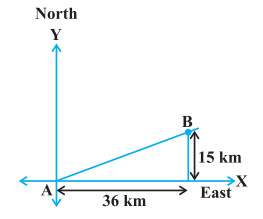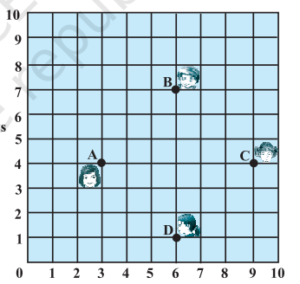Q1. Find the distance between the following pairs of points : (i) (2, 3), (4, 1) (ii) (– 5, 7), (– 1, 3) (iii) (a, b), (– a, – b)
Solution 1
Q2. Find the distance between the points (0, 0) and (36, 15). Can you now find the distance between the two towns A and B discussed in figure.
Solution 2.
Q3. Determine if the points (1, 5), (2, 3) and (– 2, – 11) are collinear.
Solution 3.
Q4. Check whether (5, – 2), (6, 4) and (7, – 2) are the vertices of an isosceles triangle.
Solution 4
Q5. In a classroom, 4 friends are seated at the points A, B, C and D as shown in Fig. Champa and Chameli walk into the class and after observing for a few minutes Champa asks Chameli, “Don’t you think ABCD is a square?” Chameli disagrees. Using distance formula, find which of them is correct.
Solution 5
Q6. Name the type of quadrilateral formed, if any, by the following points, and give reasons for your answer: (i) (– 1, – 2), (1, 0), (– 1, 2), (– 3, 0) (ii) (–3, 5), (3, 1), (0, 3), (–1, – 4) (iii) (4, 5), (7, 6), (4, 3), (1, 2)
Solution 6
Q7. Find the point on the x-axis which is equidistant from (2, –5) and (–2, 9).
Solution 7
Q8. Find the values of y for which the distance between the points P(2, – 3) and Q(10, y) is 10 units.
Solution 8
Q9. If Q (0, 1) is equidistant from P(5, –3) and R(x, 6), find the values of x. Also find the distances QR and PR.
Solution 9
Q10. Find a relation between x and y such that the point (x, y) is equidistant from the point (3, 6) and (– 3, 4).
Solution 10

